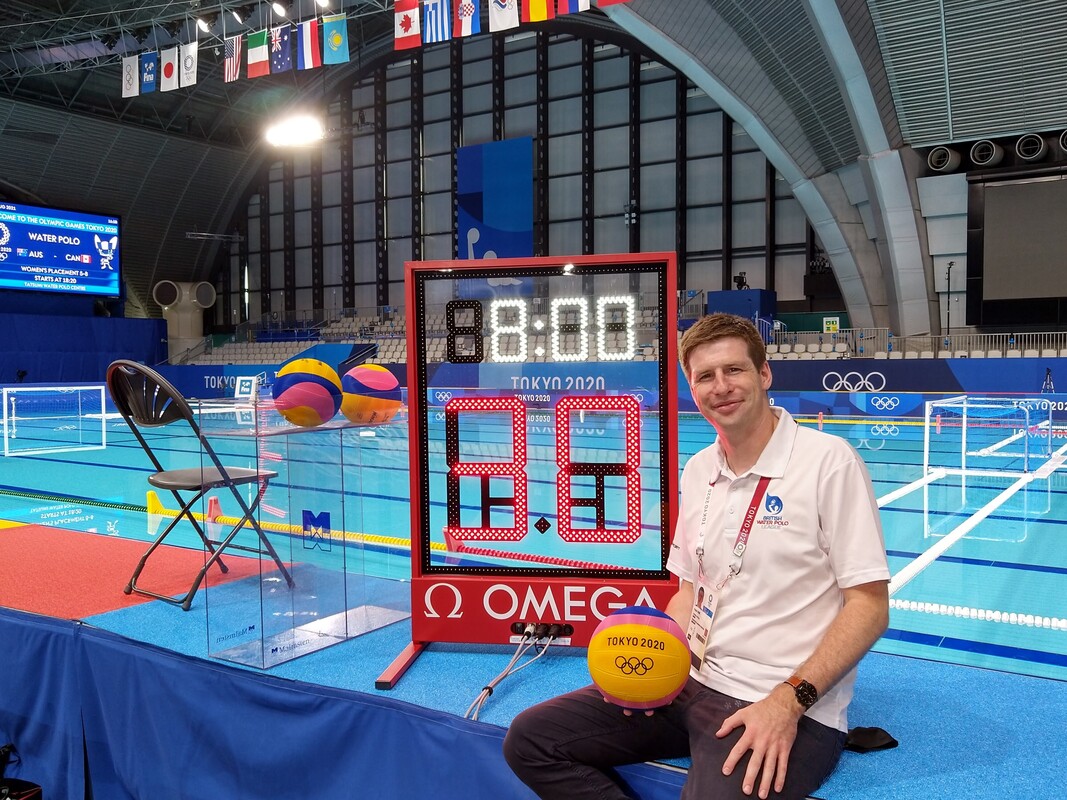
Taking part in the Olympics is a fantastic experience for any athlete – or official.
BWPL is proud that one of its former referees, Frank Ohme, is now one of the world’s top refs, taking charge in Tokyo of many of the major matches, including the women’s bronze medal clash between Hungary and Russia and the Hungary/Croatia men’s quarter-final. He also refereed two games involving eventual men’s champions Serbia.
Frank, now back in his native Germany, penned this fascinating report on his experiences in Japan. He's pictured in the Olympics pool in Tokyo - wearing his BWPL shirt!
"The Olympic Games are always unique and full of memorable moments. Obviously, this year's Olympics were extra special. Not only because all those "Tokyo2020" banners seem to have missed a year (which many of us might want to forget, too), or because 10,000 Olympians and officials started each day with a new COVID test.
This year's Olympic water polo tournament was also notable because the sport is going through a significant transition to make it more attractive and assure its place in the Olympic programme for the foreseeable future.
For the first time, 10 (instead of previously eight) women's teams participated alongside 12 men's squads. In response to worries about increasing numbers of athletes, only 12 players were allowed to line up for each match per team. Coaches could decide: do we start with two goalkeepers (numbered 1 and 13) or only one?
The latter option came with the exciting possibility of replacing the designated goalie with any field player wearing the red cap with their field number. If you watched enough games, you might have spotted some of those 7-on-6 attacks in the final seconds of a close match. It is unclear if we will ever see this rule at major tournaments again, but it certainly added a little extra excitement.
There were other changes in the game that we definitely will keep seeing in the future. FINA promotes a less physical, more diverse and skilful style of playing water polo. We referees are instructed to protect the movement of players and do not allow constant holding, both in the perimeter and at the centre forward.
This creates new and old challenges for us. The two refs on the poolside have to perfectly cover the field of play. Any action, on and off the ball, can be crucial. As we keep the game as clean as possible, we need to avoid calling an apparent foul that is only the reaction to a first action we missed. For example, a defender might be on top of a driver who pulled themselves underneath; a centre-forward might push off a defender who has been trying to drown them for the past 20 seconds.
These situations need quick reactions from the referees on the first foul or no whistle at all if deemed irrelevant at this moment. Luckily, the radio communication system that has become standard at international events helps the referees to find a common standard quickly.
Especially during the Olympics, there is a lot more technology involved. More than 20 cameras watch the action, some from underwater, some hanging from the ceiling, some are placed right next to the referee. Eight of those cameras are not for the broadcasters but for the Video Assistant Referee (VAR). Two extra monitors adjacent to the field belong to that system, and they are the place to go if we need to check if a ball has actually crossed the goal line.
Sometimes, despite 100 frames per second in high resolution looking exactly along the goal line, it is hard to make that call - but in the end, it is far more accurate than what mere humans can see during live action, or even in the TV's slow motions.
So, refereeing at the top level is in some ways easier than at the local league. There is technology to help. There is a large group of people running and supporting the table. And there are professional players who can work with the line the referees are defining. Although the stakes are as high as it gets in our sport (Olympic medals!), the discipline in the water and on the benches is equally high, with very few exceptions.
Nevertheless, the referees are expected to perform as professionally as the players are. We are given some space to manage the game using our best judgement, but if mistakes happen, and they do happen regularly, they will be thoroughly reviewed.
One of those reviews happens immediately after the game, in a small room with a screen showing crucial parts of the game selected by the delegates. Other reviews happen more informally. After all, the entire water polo community is watching the games we referee, including the top officials from all over the world. Each Olympic referee watches most matches that they do not have to officiate from the otherwise empty stands. After, there are many opportunities to chat (over hot or cold beverages) about what happened in the pool.
I experienced a similar atmosphere of friendly and constructive feedback as a BWPL referee. In fact, being with many different referees, delegates and players during those BWPL weekends and listening to everyone's ideas of water polo was excellent preparation for refereeing on the big stage – because officiating women's and men's games on various levels while constantly receiving (good and bad) feedback is the best way to grow as a referee.
One has to become confident in one's own abilities while maintaining enough flexibility and humbleness to never forget what a good referee must be: a service to the teams. Service to the sport."
BWPL is proud that one of its former referees, Frank Ohme, is now one of the world’s top refs, taking charge in Tokyo of many of the major matches, including the women’s bronze medal clash between Hungary and Russia and the Hungary/Croatia men’s quarter-final. He also refereed two games involving eventual men’s champions Serbia.
Frank, now back in his native Germany, penned this fascinating report on his experiences in Japan. He's pictured in the Olympics pool in Tokyo - wearing his BWPL shirt!
"The Olympic Games are always unique and full of memorable moments. Obviously, this year's Olympics were extra special. Not only because all those "Tokyo2020" banners seem to have missed a year (which many of us might want to forget, too), or because 10,000 Olympians and officials started each day with a new COVID test.
This year's Olympic water polo tournament was also notable because the sport is going through a significant transition to make it more attractive and assure its place in the Olympic programme for the foreseeable future.
For the first time, 10 (instead of previously eight) women's teams participated alongside 12 men's squads. In response to worries about increasing numbers of athletes, only 12 players were allowed to line up for each match per team. Coaches could decide: do we start with two goalkeepers (numbered 1 and 13) or only one?
The latter option came with the exciting possibility of replacing the designated goalie with any field player wearing the red cap with their field number. If you watched enough games, you might have spotted some of those 7-on-6 attacks in the final seconds of a close match. It is unclear if we will ever see this rule at major tournaments again, but it certainly added a little extra excitement.
There were other changes in the game that we definitely will keep seeing in the future. FINA promotes a less physical, more diverse and skilful style of playing water polo. We referees are instructed to protect the movement of players and do not allow constant holding, both in the perimeter and at the centre forward.
This creates new and old challenges for us. The two refs on the poolside have to perfectly cover the field of play. Any action, on and off the ball, can be crucial. As we keep the game as clean as possible, we need to avoid calling an apparent foul that is only the reaction to a first action we missed. For example, a defender might be on top of a driver who pulled themselves underneath; a centre-forward might push off a defender who has been trying to drown them for the past 20 seconds.
These situations need quick reactions from the referees on the first foul or no whistle at all if deemed irrelevant at this moment. Luckily, the radio communication system that has become standard at international events helps the referees to find a common standard quickly.
Especially during the Olympics, there is a lot more technology involved. More than 20 cameras watch the action, some from underwater, some hanging from the ceiling, some are placed right next to the referee. Eight of those cameras are not for the broadcasters but for the Video Assistant Referee (VAR). Two extra monitors adjacent to the field belong to that system, and they are the place to go if we need to check if a ball has actually crossed the goal line.
Sometimes, despite 100 frames per second in high resolution looking exactly along the goal line, it is hard to make that call - but in the end, it is far more accurate than what mere humans can see during live action, or even in the TV's slow motions.
So, refereeing at the top level is in some ways easier than at the local league. There is technology to help. There is a large group of people running and supporting the table. And there are professional players who can work with the line the referees are defining. Although the stakes are as high as it gets in our sport (Olympic medals!), the discipline in the water and on the benches is equally high, with very few exceptions.
Nevertheless, the referees are expected to perform as professionally as the players are. We are given some space to manage the game using our best judgement, but if mistakes happen, and they do happen regularly, they will be thoroughly reviewed.
One of those reviews happens immediately after the game, in a small room with a screen showing crucial parts of the game selected by the delegates. Other reviews happen more informally. After all, the entire water polo community is watching the games we referee, including the top officials from all over the world. Each Olympic referee watches most matches that they do not have to officiate from the otherwise empty stands. After, there are many opportunities to chat (over hot or cold beverages) about what happened in the pool.
I experienced a similar atmosphere of friendly and constructive feedback as a BWPL referee. In fact, being with many different referees, delegates and players during those BWPL weekends and listening to everyone's ideas of water polo was excellent preparation for refereeing on the big stage – because officiating women's and men's games on various levels while constantly receiving (good and bad) feedback is the best way to grow as a referee.
One has to become confident in one's own abilities while maintaining enough flexibility and humbleness to never forget what a good referee must be: a service to the teams. Service to the sport."

 RSS Feed
RSS Feed

